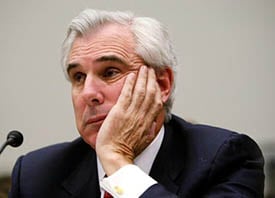 The American Bankers Association wants the Treasury Department to clear something up: Just because the government is doling out money to its members through the Troubled Asset Relief Program doesn’t mean that those who do or do not receive the funds are, well, troubled.
The American Bankers Association wants the Treasury Department to clear something up: Just because the government is doling out money to its members through the Troubled Asset Relief Program doesn’t mean that those who do or do not receive the funds are, well, troubled.
The Treasury Department has been unwilling to release a full list of who has asked for the funds for fear of harming the receiving institution’s reputation or casting doubt on firms that did not get the money. Testifying this morning on the TARP program before the House Committee on Small Business, Stephen Wilson, a top official at the association, told Congress his industry wants the capital injections but is worried about the stigma that may come along with them.
“Many banks were initially concernedâand still remain concernedâthat the market will incorrectly perceive this as a sign of the weakness in the industry,” Wilson said according to a prepared statement.
In an economic crisis where insecurity can quickly lead to panicked behavior like bank runs, his concern may be merited. In Australia, a recent pledge by the government to back bank deposits has created a stampede of investors withdrawing money from pensions and other funds. The government inadvertently created a two-tiered system with the perception that bank deposits were safe and everything else wasn’t.
Part of the confusion in the U.S. rests with the Treasury Department itself. An evolving plan of action and an apparent inability to explain itself have raised doubts both about Treasury’s motives and its capabilities.
Originally devised to buy ailing mortgage backed securities, the bailout quickly shifted to lending money to banks so they could lend and dethaw frozen credit markets. Last week, yet another use for the capital injections emerged. Strong banks will use the government money to swallow weaker banks. While this may save the Federal Deposit Insurance Fund the expense of bailing out tottering institutions it has small community banks upset at what they see as giving their competitors an unfair advantage.
“[G]overnment officials, particularly members of Congress, have provided widely differing interpretations and recommendations with respect to what the program is designed to do, what it means to and about banks that participate, and what requirements should accompany participation in the program, both now and in the future,” complained ABA President Edward Yingling in a recent letter to Treasury Secretary Henry Paulson(PDF).
Wilson, who is the CEO of a small bank in Lebanon, Ohio, testified today (PDF) that about half of the bank lobby’s members might ultimately participate in the program, if Treasury does a better job both of explaining and defining it. (The American Bankers Association does not reveal the number of banks it represents but says that they hold over 96 percent of the industry’s $13.3 trillion in assets.) Yet he also cautioned that whether a bank received government money or didn’t shouldn’t be the last word on financial health.
“It will also be important for regulators to recognize that many well-capitalized banks have sufficient liquidity and are meeting credit needs in their communities,” Wilson testified. “These banks may not want to participate in the program and no negative consequences should come from that decision.”
Others agree that the entire banking industry shouldn’t be tarred with the same brush. “Most medium banks are fine,” says Christopher Whalen, managing director of the research firm Institutional Risk Analytics. Unfortunately, the majority of bank assets are highly concentrated at the top. It is here, where “loss rates are much higher.”


